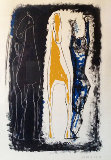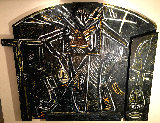-

-
Jean Helion
FranceArt Brokerage: Jean Helion French Artist: b. 1904-1987. He was born at Couterne in Normandy in 1904 was a French painter whose abstract work of the 1930s established him as a leading modernist. His midcareer rejection of abstraction was followed by nearly five decades as a figurative painter. In 1921, Jean Helion lived in Paris where he wrote poetry and worked as an architectural apprentice. He experienced what he called the great turning point of his life while on a research project at the Louvre, where he discovered the works of Poussin and Philippe de Champaigne, and decided to become a painter. His first paintings date from 1922-1923. Hélion moved to the United States in July 1936, staying in New York and later Virginia. While he continued painting abstractly, he increasingly felt that his work was tending toward representation, and he began drawing from life. His work underwent a radical change one that would confound his admirers when he abandoned abstraction decisively in 1939. His first large-scale figurative canvas, With Cyclist (Au cycliste), revealed a simplified and streamlined treatment of form that is related to Léger's style of the 1930s. Hélion resumed work in 1943 with a series of depersonalized images of men in hats. Deliberative as always, he painted many close variations on favorite themes, including women at open windows and men reading newspapers. In the following years he developed the cartoon-like aspect of the style he had embraced, producing in 1949 a series of awkward, bony female nudes which have few parallels in the history of art. In 1951 came another of the abrupt changes that mark his career, as Hélion adapted a naturalistic style. For the next several years he concentrated mostly on figures and still lifes, depicted in a studio setting. nIn the 1960s his manner reverted to something closer to his style of the 1940s, but with a new breadth, and he abandoned oils for acrylic. During the next two decades he would paint several large triptychs. His subject matter revealed, as it always had, a preoccupation with sometimes idiosyncratic themes: artists and models, sliced-open squashes, umbrellas, accidental falls, street scenes and street repair. In the last years of his life his eyesight failed and his last painting was completed in 1983, four years before his death. Listings wanted.
Read More + - Create Listing 0 Artworks for sale 2 Followers
-
We are actively seeking listings for Jean Helion.
Create a free listing or free wanted ad.






























